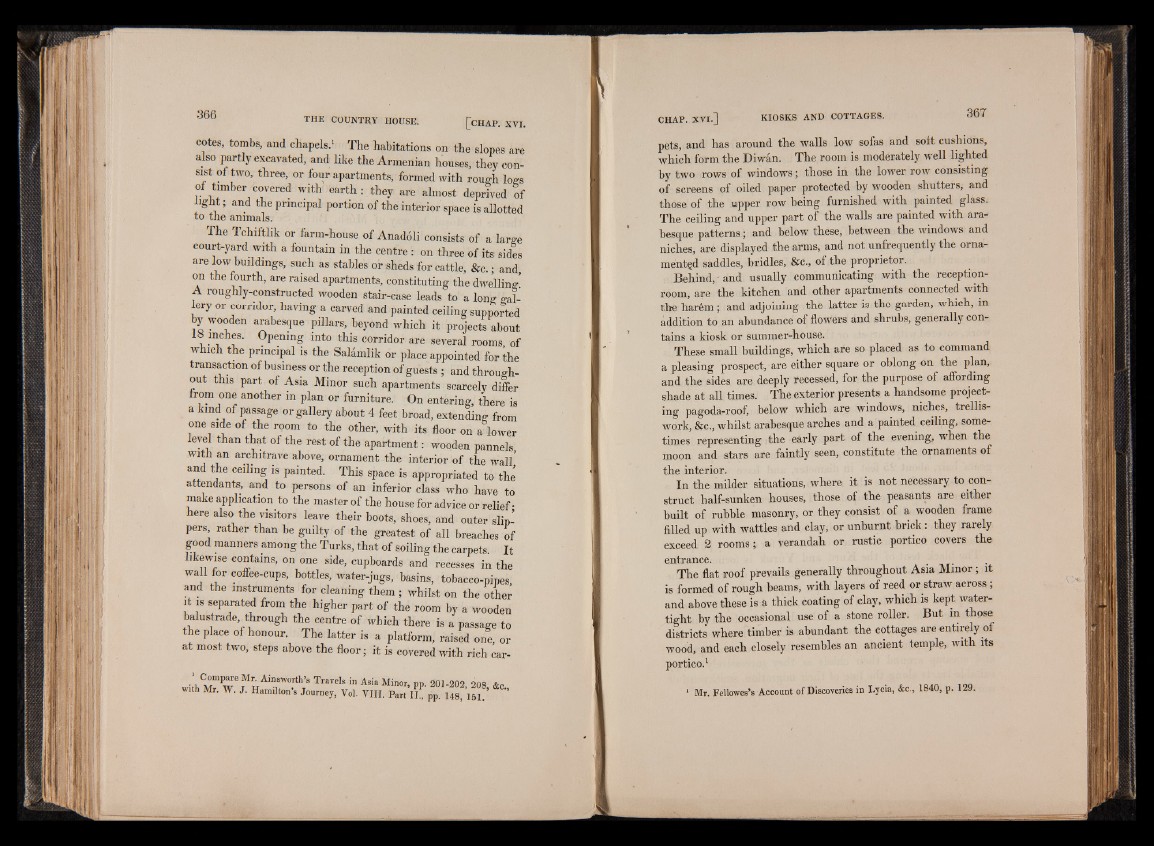
cotes, tombs, and chapels.V The habitations on the slopteesa aarree
a so partly excavated, and like the Armenian houses, they consist
of two, three, or four apartments, formed with rough logs
of timber covered with earth : they are almost deprived of
light; and the principal portion of the interior space is allotted
to the animals.
The Tchiftlik or farm-house of Anadoli consists of a large
court-yard with a fountain in the centre : on three of its sides
are low buildings, such as stables or sheds for cattle, See.; and
on the fourth, are raised apartments, constituting the dwelling
A roughly-constructed wooden stair-case leads to a long gallery
or corridor, having a carved and painted ceiling supported
by wooden arabesque pillars, beyond which it projects about
18 inches. Opening into this corridor are several rooms, of
which the principal is the Salamlik or place appointed for the
transaction of business or the reception of guests ; and throughout
this part of Asia Minor such apartments scarcely differ
from one another in plan or furniture. On entering, there is
a kind of passage or gallery about 4 feet broad, extending from
one side of the room to the other, with its floor on a lower
level than that of the rest of the apartment: wooden pannels
with an architrave above, ornament the interior of the wall*
and the ceiling is painted. This space is appropriated to the'
attendants, and to persons of an inferior class who have to
make application to the master of the house for advice or relief-
here also the visitors leave their boots, shoes, and outer slippers
rather than be guilty of the greatest of all breaches of
good manners among the Turks, that of soiling the carpets. It
likewise contains, on one side, cupboards and recesses in the
wall for coffee-cups, bottles, water-jugs, basins, tobacco-pipes
and the instruments for cleaning them ; whilst on the other
it is separated from the higher part of the room by a wooden
balustrade through the centre of which there is a passage to
the place of honour. The latter is a platform, raised one, or
at most two, steps above the floor; it is covered with rich carw
i ^ f T T1 H AlnSW°,rth’s Trave,s in Asia Minor, pp. 201-202, 208, &c.,
with Mr. W. J. Hamilton s Journey, Vol. VIII. Part II., pp. 148, 151.
pets, and has around the walls low sofas and soft cushions,
which form the Diwan. The room is moderately well lighted
by two rows of windows; those in the lower row consisting
of screens of oiled paper protected by wooden shutters, and
those of the upper row being furnished with painted glass.
The ceiling and upper part of the walls are painted with arabesque
patterns; and below these, between the windows and
niches, are displayed the arms, and not unfrequently the ornamented
saddles, bridles, &c., of the proprietor.
Behind, i and usually communicating with the reception-
room, are the kitchen and other apartments connected with
the harem; and adjoining the latter is the garden, which, in
addition to an abundance of flowers and shrubs, generally contains
a kiosk or summer-house.
These small buildings, which are so placed as to command
a p le a s in g prospect, are either square or oblong on the plan,
and the sides are deeply recessed, for the purpose of affording
shade at all times. The exterior presents a handsome projecting
pagoda-roof, below which are windows, niches, trellis-
work, &c., whilst arabesque arches and a painted ceiling, sometimes
representing the early part of the evening, when the
moon and stars are faintly seen, constitute the ornaments of
the interior.
In the milder situations, where it is not necessary to construct
half-sunken houses, those of the peasants are either
built of rubble masonry, or they consist of a wooden frame
filled up with wattles and clay, or unburnt brick: they rarely
exceed 2 rooms; a verandah or rustic portico covers the
entrance.
The flat roof prevails generally throughout Asia Minor; it
is formed of rough beams, with layers of reed or straw across;
and above these is a thick coating of clay, which, is kept watertight
by the occasional use of a stone roller. But in those
districts where timber is abundant the cottages are entirely of
wood, and each closely resembles an ancient temple, with its
portico.1
1 Mr. FellowesV Account of Discoveries in Lycia, &c., 1840, p. 129.